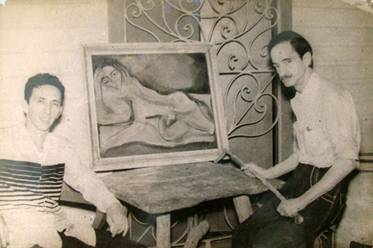The assertion may be controversial, risky, but within an intelligentsia as diverse as the twentieth-century Cuban, within a cultural process with such rich manifestations, within a cataurus so well nourished with attractive personalities, Carlos Enríquez , the painter-writer, or the painter writer, as you prefer, is one of the most unique characters in the context of twentieth-century Cuban culture.
He was a real character with overtones of legend. His workshop residence in the Havana municipality of Arroyo Naranjo, the well-known Blue Huron, is a place of worship and a must-see for those who want to delve into his personality, his inner world, his bohemian multifaceted artist.
A lot has been written about his painting. "The painter must be something more than a meek seal or a trained horse that astonishes the spectators tricked into a provincial circus by their abilities ... It is necessary to look for the vernacular in the countryside of Cuba," he declared long ago. And it was he himself who, giving the example, expressed his stylized and personal interpretation of Guajiro folklore in several paintings, although one became emblematic: The abduction of the mulatas , with other samples of his trade in which he named Manuel García, king of the fields of Cuba and Happy Peasants, a scathing title when you see the moving faces that are captured in it.
Less has been said about his condition as a narrator, who did not deliver exceptional but decent fruits, by which he can also be judged. Nature was generous to him by endowing him with the mastery of two arts, in him complementary, which illustrate an apparently wild character, and in reality irreverent and antidogmatic.
His narrative work ‒que is what concerns us‒ was published almost entirely posthumously. It comprises three novels: Tilín García, The Return of Chencho and The Fair of Gaucanama ; in them high-flying prose landscapes are interwoven with others in which the style declines.
The first of the cited texts was published with a foreword by his friend the poet Félix Pita Rodríguez , a roommate in Paris in the 1930s; The critic Max Henríquez Ureña wrote about this title, which is "a realistic novel from the countryside of Cuba, with an accurate description of the environment and a good presentation of types and characters," although he qualifies Carlos Enríquez's prose as uneven, since "it is seen that He always wrote quickly and reluctantly ”, recognizing however“ his gift of observation and entertaining art of narrating ”. In any case, the prose of Carlos Enríquez reveals his sensitivity when he puts into practice the art of narration.
Born on August 3, 1900 in Zulueta, today the province of Villa Clara, and the son of the doctor Enríquez Costa, he inherited his taste for brushes from a grandfather who was fond of painting.
He went to North America by family design to study Commerce in Trenton and later entered the Academy of Fine Arts in Philadelphia, from which he was separated by the incompatibility of the young student with the academic precepts taught there.
He returned to Cuba just at the time when Víctor Manuel brought together the plastics of the so-called ‒entre nosotros‒ «generation of 27», in which they converge, with similar ages, Amelia Peláez , Marcelo Pogolotti , Wifredo Lam , Antonio Gattorno , Eduardo Abela , as well as Carlos Enríquez and Víctor Manuel himself.
He exhibited at the group show sponsored by Revista de Avance in 1927 and at the Lyceum two years later. Before turning 30 he was recognized as one of the most significant young painters of the first three decades of the century.
The profiles of his character, his life and occurrences border the limits of a romantic episode. If on the plane of opinions he was an implacable critic of what seemed unjust to him, on a personal level he was a detached and generous individual, a wasteful of his goods and talent, a natural rebel in his own way, bohemian, and for those who sought him objections that would discredit the witnessing force of his canvases, a "madman," a "cursed," an "eccentric," a "drunk," a "spoiled," and other niceties of the sort. He died at the age of 57, on May 2, 1957. Celebrating each of his birthday - even if it is not a closed number - implies honoring a personality whose presence on canvases and words makes him an artist who deserves the growing interest of that today is an object.


Deje un comentario